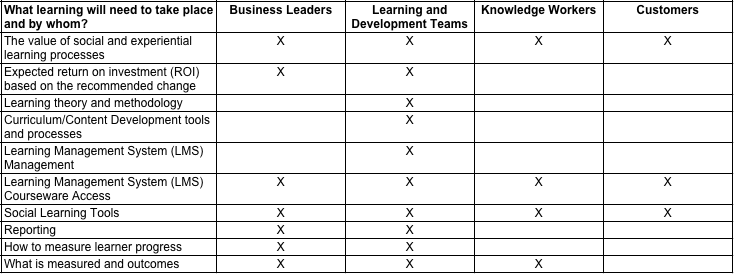The learning context for the change from the Behaviorist to Social Constructivist approach to learning is a corporate structure with the following stakeholders: Business leaders, learning and development personnel, knowledge workers and customers. Each of these stakeholders have a vested interest in this change and represents an opportunity for change leadership through appropriately framing the problem, demonstrating the value of the change, and providing a structure of support for the development of the new mindset and culture required for this change to be successful.
How the learning needs and challenges be addressed:
The value of social and experiential learning processes:
This will be addressed by preparing a clear messaging campaign that is built in cooperation with representatives from each stakeholder group. The message will need to be clear, concise, identify the “from/to” state of the change, and include a compelling call to action for each stakeholder. There will be barriers and resistance to change at many levels, including cost, time to invest in new ways of learning together, and doubt of the outcomes. By bringing representatives from each stakeholder group together and having an open dialogue about these barriers the expectation would be that each barrier could be fully expressed and an action plan for addressing and/or resolving this challenge to the change would be created. When all stakeholders are included in the decisions and processes they have shared ownership and interest in the success of the change. This sharing of responsibility and alignment of outcomes will be critical to overcome challenges and resistance to the change.
Expected return on investment (ROI) based on the recommended change:
ROI is a challenging area to address for any change process. In this case key stakeholder representatives would be brought together to line out the appropriate measures of success for the effort and tie that to the expected investment in time and money to fully implement the change. As a change of this magnitude impacts all aspects of the organization a realistic measurement of ROI may be impossible. Nonetheless, there are specific areas that can be measured, as indicated in the opportunity for change document.
Learning theory and methodology:
Round table discussions with the members of the L&D team to review the characteristics and relative benefits and drawbacks to both Behaviorism and Social Constructivism will be held. These sessions will include opportunities to apply each theory in short learning examples and provide input and feedback of the two models. In addition a workshop on using the Understanding by Design process to focus on the overarching learning objective (Big Idea) and how to apply Essential Questions to drive the reflective and social aspects of learning will be held.
Curriculum/Content Development tools and processes:
Learning sessions on building course content using the new theories, tools, and processes will be held for all learning and development team members.
Learning Management System (LMS) Management:
Hands-on learning sessions in the management of the LMS.
Learning Management System Courseware Access:
Interactive learning sessions providing the foundations of how to access and navigate various types of learning content on the LMS.
Social Learning Tools:
Introductory learning course on how to engage in the social learning tools and processes, including: Blogs, Wikis, Discussion Forums, Rating Systems, etc.
Reporting:
Hands-on learning sessions in the reporting aspects of the system.
How to measure learner progress:
Hands-on learning sessions in measurement of learner progress.
What is measured and outcomes:
Interactive learning session hosted on the LMS with details of how learners progress will be measured, how they can view this information and use it as part of an ongoing development plan.

